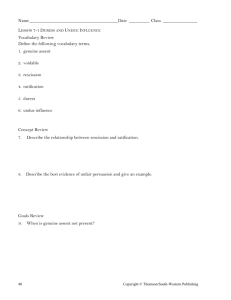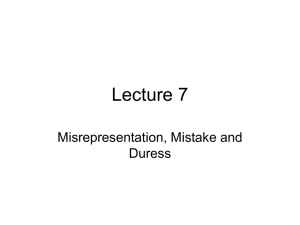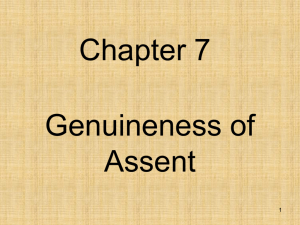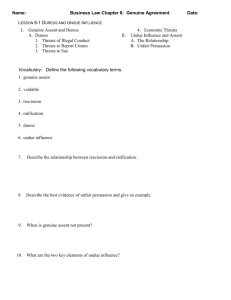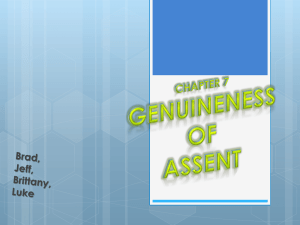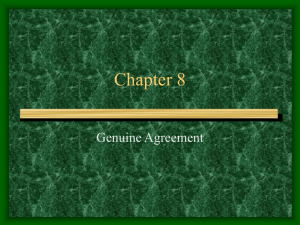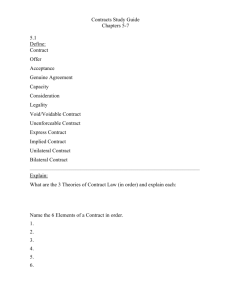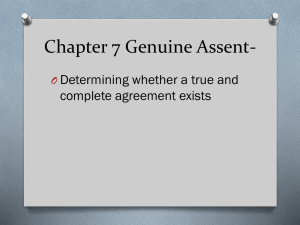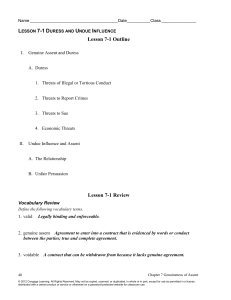Chapter 7 Outline of Law for Business and Personal Use
advertisement
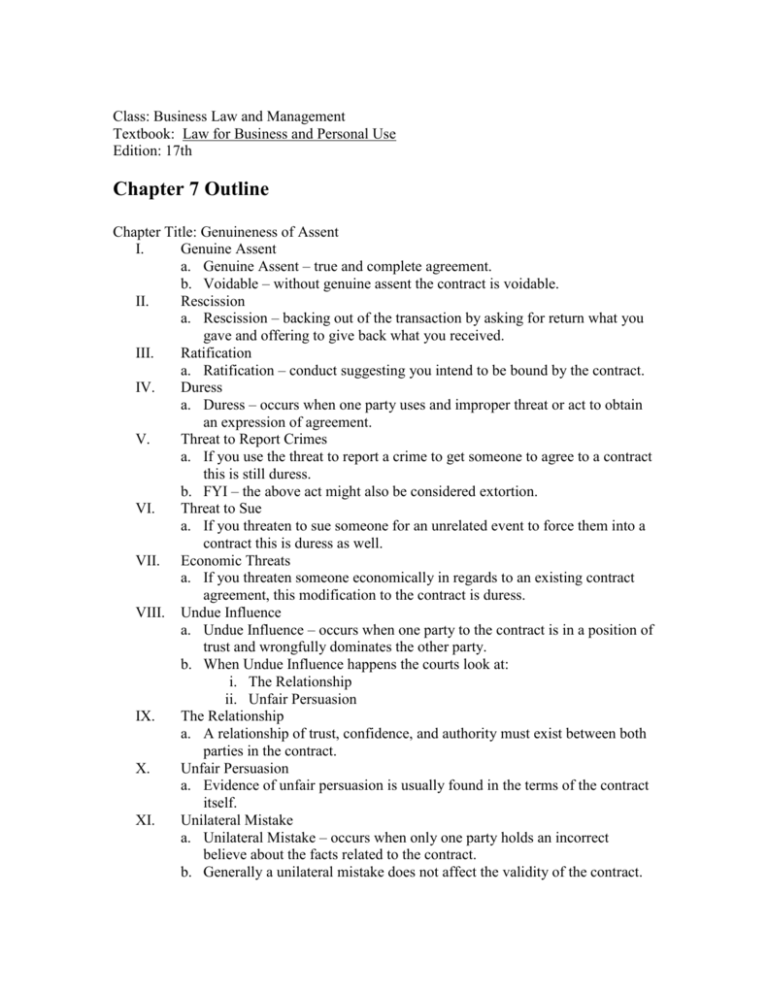
Class: Business Law and Management Textbook: Law for Business and Personal Use Edition: 17th Chapter 7 Outline Chapter Title: Genuineness of Assent I. Genuine Assent a. Genuine Assent – true and complete agreement. b. Voidable – without genuine assent the contract is voidable. II. Rescission a. Rescission – backing out of the transaction by asking for return what you gave and offering to give back what you received. III. Ratification a. Ratification – conduct suggesting you intend to be bound by the contract. IV. Duress a. Duress – occurs when one party uses and improper threat or act to obtain an expression of agreement. V. Threat to Report Crimes a. If you use the threat to report a crime to get someone to agree to a contract this is still duress. b. FYI – the above act might also be considered extortion. VI. Threat to Sue a. If you threaten to sue someone for an unrelated event to force them into a contract this is duress as well. VII. Economic Threats a. If you threaten someone economically in regards to an existing contract agreement, this modification to the contract is duress. VIII. Undue Influence a. Undue Influence – occurs when one party to the contract is in a position of trust and wrongfully dominates the other party. b. When Undue Influence happens the courts look at: i. The Relationship ii. Unfair Persuasion IX. The Relationship a. A relationship of trust, confidence, and authority must exist between both parties in the contract. X. Unfair Persuasion a. Evidence of unfair persuasion is usually found in the terms of the contract itself. XI. Unilateral Mistake a. Unilateral Mistake – occurs when only one party holds an incorrect believe about the facts related to the contract. b. Generally a unilateral mistake does not affect the validity of the contract. XII. XIII. XIV. XV. XVI. XVII. XVIII. XIX. XX. c. “Experience is the name everyone gives to their mistakes.” Oscar Wilde Mutual Mistake a. Also known as a Bilateral Mistake b. Mutual Mistake – is when both parties have a incorrect belief about an important fact (called Material Facts) in the contract. Void Contracts Due to a Mutual Mistake a. A mutual mistake can make a contract void (without legal effect) b. “A man who has committed a mistake and doesn't correct it is committing another mistake.” Confucius c. HOWEVER: Mutual mistakes made about applicable laws do not void a contract. i. All persons are presumed to know the law. Innocent Misrepresentation a. When you make a mistake about a material fact in a contract without knowing it. Fraudulent Misrepresentation a. When you make a mistake about a material fact in a contract and are aware that you are doing so. b. Statements are treated as misrepresentations by the law only if: i. The untrue statement is one of fact, or there is active concealment. ii. The statement is material to the transaction. iii. The victim reasonably relied on the statement. Untrue Statement of Fact a. The misrepresentation of statement must be one of fact rather than opinion. b. When an expert expresses and opinion the law will treat it as a fact. Active Concealment a. Active concealment – is the substitute of a false statement of fact. Silence a. In most cases the seller may remain silent about defects. b. HOWEVER: there are three situations where the seller must disclose defects. i. Where a statement of material fact omits important information. ii. When a true statement is made false by subsequent events. iii. When one party knows the other party has made a basic mistaken assumption. Materiality a. The untrue statement must be determined to be material (important and relevant). b. A statement is material if: i. It would cause a reasonable person to contract. ii. The defendant knew the plaintiff would rely on the statement. iii. If the defendant knew the statement was false. Reasonable Reliance a. Even if a statement is material, there is no representation unless the victim reasonably relied on it. XXI. Fraud a. Fraud – all of the elements of misrepresentation must be proven and the additional elements of: intent and injury. XXII. The Misrepresentation Must be Intention or Reckless a. The misrepresentation must be intended to induce the victim to contract. XXIII. The Misrepresentation or Concealment Must Injure. a. There must be proof of injury. XXIV. Remedies for Fraud a. Rescission – the victim may back out of the contract. i. Anything you received must be returned. b. Damages – the defrauded party may choose to ratify the agreement then seek damages for loss created by the fraud.
